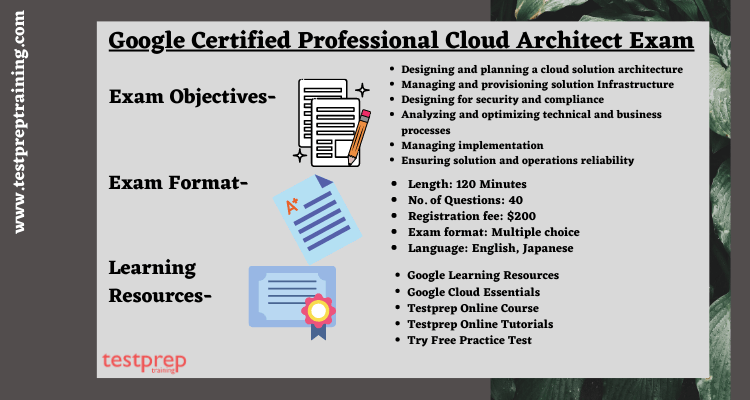As a Google Certified Professional Cloud Architect, you’ll possess the expertise to utilize Google Cloud technologies for organizational needs. With a strong understanding of cloud architecture and the Google Cloud Platform, you can design, build, and oversee robust, secure, scalable, highly available, and dynamic solutions to achieve business goals. However, we’ve put together this post to assist you in comprehending the test’s difficulty level as well as providing specific exam information and study materials to aid in your preparation.
The Google Cloud Certified – Professional Cloud Architect exam assesses the candidate’s ability to do the following:
- Firstly, designing and planning a cloud solution architecture
- Secondly, managing and provision the cloud solution infrastructure
- Also, designing for security and compliance
- Further, analyzing and optimizing technology and business processes
- In addition, managing implementations of cloud architecture
- Moreover, ensuring solution and operations reliability
Is Google Professional Cloud Architect Exam worth it?
Cloud service has become more popular than ever before due to a rise in demand for cloud service specialists in the IT sector. People are becoming increasingly interested in cloud services, hence Google Cloud Architect certification was created. Employers nowadays are concerned about IT specialists. They have a far better grasp of the IT business, which will help them create a career in it. Furthermore, it enables them to integrate a cloud environment as transparently as possible into their architecture.
What makes the Google Certified Professional Cloud Architect Exam difficult?
The Google Certified Professional Cloud Architect exam is one of the challenging exams. The candidate has to prepare for the exam with numerous efforts. The candidate will have to put in a lot of work in order to pass the exam. The difficulty of the Google cloud test stems from the certification procedure, which is solely focused on professionally performing the Cloud Architect function rather than the platform itself. This provides a lot of value since it better represents real-world abilities. However, because many queries have nothing to do with Google, this might be a huge disadvantage for the applicants. Given the dynamic nature of the Google Cloud Architect Certification Exam, it’s critical to have a Google Cloud Architect exam preparation approach that’s just as dynamic. That is, integrating several online and offline learning strategies to gain a thorough understanding of the subject.
Cloud Architect Exam Details:
You’re ready to go once you have the details in your hands. The Google Certified Professional Cloud Architect exam consists of 40 multiple-choice questions and takes 120 minutes to complete. The test is valid for two years after it has been passed. However, no passing score is assigned to the exam. The test is offered in two languages: English and Japanese. Above all, the exam will set you back $200 USD. For registering for the Google Certified Professional Cloud Architect exam, you can go to the Official Google Cloud website.
Exam Course Outline
We are making it a little easy for you by providing the course structure of the Google Certified Professional Cloud Architect exam.
Domain 1: Designing and planning a cloud solution architecture (24%)
1.1 Designing a solution infrastructure that meets business requirements. Considerations include:
- Business use cases and product strategy (Google Documentation: Best practices for enterprise organizations, Implementing policies for customer use cases)
- Cost optimization (Google Documentation: Performance and cost optimization)
- Supporting the application design (Google Documentation: Google Cloud system design considerations)
- Integration with external systems (Google Documentation: Using APIs from an External Network, Security, privacy, and compliance)
- Movement of data (Google Documentation: Data lifecycle)
- Design decision trade-offs (Google Documentation: Google Cloud system design considerations)
- Build, buy, or modify
- Success measurements (e.g., key performance indicators [KPI], return on investment [ROI], metrics) (Google Documentation: KPIs for APIs: How Metrics Change Over Time)
- Compliance and observability (Google Documentation: Security, privacy, and compliance)
1.2 Designing a solution infrastructure that meets technical requirements. Considerations include:
- High availability and failover design (Google Documentation: Overview of the high availability configuration)
- The elasticity of cloud resources (Google Documentation: Google Cloud overview)
- Scalability to meet growth requirements (Google Documentation: Reliability, Security, privacy, and compliance)
- Performance and latency (Google Documentation: Performance and cost optimization)
1.3 Designing network, storage, and compute resources. Considerations include:
- Integration with on-premises/multi-cloud environments (Google Documentation: Hybrid and multi-cloud architecture patterns)
- Cloud-native networking (VPC, peering, firewalls, container networking) (Google Documentation: VPC network overview)
- Choosing data processing technologies (Google Documentation: Data processing, Dataflow, Dataproc)
- Choosing appropriate storage types (e.g., object, file, RDBMS, NoSQL, NewSQL) (Google Documentation: Google Cloud Databases)
- Choosing to compute resources (e.g., preemptible, custom machine type, specialized workload) (Google Documentation: Compute, Creating a VM Instance with a custom machine type)
- Mapping compute needs to platform products (Google Documentation: Google Cloud products)
1.4 Creating a migration plan (i.e., documents and architectural diagrams). Considerations include:
- Integrating solution with existing systems (Google Documentation: Migration to Google Cloud: Getting started)
- Migrating systems and data to support the solution
- Licensing mapping (Google Documentation: Bringing your own licenses)
- Network planning (Google Documentation: Best practices and reference architectures for VPC design, VPC network overview))
- Testing and proof of concept (Google Documentation: Running a hybrid render farm proof of concept)
- Dependency management planning (Google Documentation: Specifying Dependencies)
1.5 Envisioning future solution improvements. Considerations include:
- Cloud and technology improvements (Google Documentation: Google Cloud Improvements)
- Business needs evolution (Google Documentation: Best practices for enterprise organizations, Google Cloud Improvements)
- Evangelism and advocacy (Google Documentation: API Team Best Practices: Developers, Evangelists, and Champions)
Domain 2: Managing and provisioning a solution Infrastructure (15%)
2.1 Configuring network topologies. Considerations include:
- Extending to on-premises (hybrid networking) (Google Documentation: Extending On-Premises Network-Attached Storage to Cloud Storage with Komprise, Google Cloud Hybrid Connectivity)
- Extending to a multicloud environment that may include Google Cloud to Google Cloud communication (Google Documentation: Hybrid and multi-cloud architecture patterns)
- Security protection (e.g. intrusion protection, access control, firewalls)
2.2 Configuring individual storage systems. Considerations include:
- Data storage allocation (Google Documentation: Best practices for Cloud Storage)
- Data processing/compute provisioning (Google Documentation: Provisioning VMs on sole-tenant nodes, Data processing, Dataflow, Dataproc)
- Security and access management (Google Documentation: Identity and Access Management)
- Network configuration for data transfer and latency (Google Documentation: GCP network performance, Performance, and cost optimization)
- Data retention and data life cycle management (Google Documentation: Data lifecycle, Retention policies and retention policy locks)
- Data growth management (Google Documentation: Data lifecycle, Cloud storage growth)
2.3 Configuring compute systems. Considerations include:
- Compute system provisioning (Google Documentation: Provisioning VMs on sole-tenant nodes, Compute Engine)
- Compute volatility configuration (preemptible vs. standard) (Google Documentation: Preemptible VM instances, Creating and starting a preemptible VM instance)
- Network configuration for compute resources (Google Compute Engine, Google Kubernetes Engine, serverless networking)
- Infrastructure orchestration, resource configuration, and patch management
- Container orchestration
Domain 3: Designing for security and compliance (18%)
3.1 Designing for security. Considerations include:
- Identity and access management (IAM) (Google Documentation: Identity and Access Management)
- Resource hierarchy (organizations, folders, projects) (Google Documentation: Resource hierarchy, Using resource hierarchy for access control)
- Data security (key management, encryption) (Google Documentation: Encryption at rest in Google Cloud)
- Separation of duties (SoD) (Google Documentation: Separation of duties)
- Security controls (e.g., auditing, VPC Service Controls, organization policy) (Google Documentation: Overview of VPC Service Controls)
- Managing customer-managed encryption keys with Cloud KMS (Google Documentation: Customer-managed encryption keys (CMEK))
- Remote access
3.2 Designing for compliance. Considerations include:
- Legislation (e.g., health record privacy, children’s privacy, data privacy, and ownership) (Google Documentation: Compliance resource center)
- Commercial (e.g., sensitive data such as credit card information handling, personally identifiable information [PII]) (Google Documentation: Scan for sensitive data in just a few clicks, Take charge of your sensitive data with the Cloud Data Loss Prevention (DLP) API)
- Industry certifications (e.g., SOC 2) (Google Documentation: SOC 2)
- Audits (including logs) (Google Documentation: Cloud Audit Logs)
Domain 4: Analyzing and optimizing technology and business processes (18%)
4.1 Analyzing and defining technical processes. Considerations include:
- Software development life cycle plan (SDLC)
- Continuous integration / continuous deployment (Google Documentation: Setting up a CI/CD pipeline)
- Troubleshooting / root cause analysis best practices
- Testing and validation of software and infrastructure (Google Documentation: Validate Your Data, Testing Overview)
- Service catalogue and provisioning (Google Documentation: Provisioning Overview)
- Business continuity and disaster recovery (Google Documentation: Disaster recovery planning guide, Solving for business continuity)
4.2 Analyzing and defining business processes. Considerations include:
- Stakeholder management (e.g. influencing and facilitation)
- Change management (Google Documentation: Opening doors, embracing change with cloud data warehouses)
- Team assessment/skills readiness (Google Documentation: Migration to Google Cloud: Assessing and discovering your workloads)
- Decision-making process
- Customer success management
- Cost optimization / resource optimization (Capex / Opex) (Google Documentation: Cloud cost optimization, Cost Management)
4.3 Developing procedures to ensure reliability of solutions in production (e.g., chaos engineering, penetration testing) (Google Documentation: Patterns for scalable and resilient apps)
Domain 5: Managing implementation (11%)
5.1 Advising development/operation team(s) to ensure successful deployment of the solution. Considerations include:
- Application development (Google Documentation: Application modernization, Application Development)
- API best practices (Google Documentation: API Key Best Practices)
- Testing frameworks (load/unit/integration) (Google Documentation: Testing Overview, test – Run gsutil unit/integration tests (for developers))
- Data and system migration tooling (Google Documentation: Data center migration)
5.2 Interacting with Google Cloud programmatically. Considerations include:
- Google Cloud Shell
- Google Cloud SDK (gcloud, gsutil and bq)
- Cloud Emulators (e.g. Cloud Bigtable, Datastore, Spanner, Pub/Sub, Firestore)
Domain 6: Ensuring solution and operations reliability (14%)
6.1 Monitoring/logging/profiling/alerting solution (Google Documentation: Introduction to alerting, Alerting behavior)
6.2 Deployment and release management (Google Documentation: Google Cloud Deployment Manager)
6.3 Assisting with the support of solutions in operation (Google Documentation: Cloud Monitoring, Operations)
6.4 Evaluating quality control measures (Google Documentation: Google security whitepaper)
Google Certified Professional Cloud Architect Study Guide

- Google Learning Resources– The Google Cloud Free Tier provides the candidate with free resources to study Google Cloud services. This becomes all the more enriching for a candidate if they are completely new to the platform and need to learn the basics. So, for that, we’re providing you two Quick links for additional resources. Google Cloud Platform Documentation and Technical Guides.
- Google Cloud Essentials– In this introductory-level quest, the candidate will get hands-on practice with Google Cloud’s fundamental tools and services. So, Google Cloud Essentials is the recommended first Quest for the Google Cloud learner.
- Testprep Training Online Course- In the Testprep training’s Google Certified Professional Cloud Architect online course, the candidate will learn the following concepts in-depth:
- Deploy managed Hadoop apps on the Google Cloud
- Make informed decisions about Containers, VMs, and AppEngine
- Understand the overall architecture and working of Google Cloud Gain ability to work on GCP practically
- Preparedness for the Cloud Architect professional exam
- Testprep Online Tutorials– Google Certified Professional Cloud Architect Online Tutorial enrich your understanding of exam concepts. They cover exam details and policies, offering in-depth information related to the examination.
- Try Practice Test– Practice tests play a crucial role in ensuring your preparation. They help identify weak areas, allowing you to focus on improvement. Testprep training provides helpful practice tests for candidates preparing for the exam.
So, it is obvious that the Google Certified Professional Cloud Architect Exam is a little challenging but with all these learning resources and material, the candidate has a definite chance to pass the exam and successfully become a Google Certified Professional Cloud Architect.



